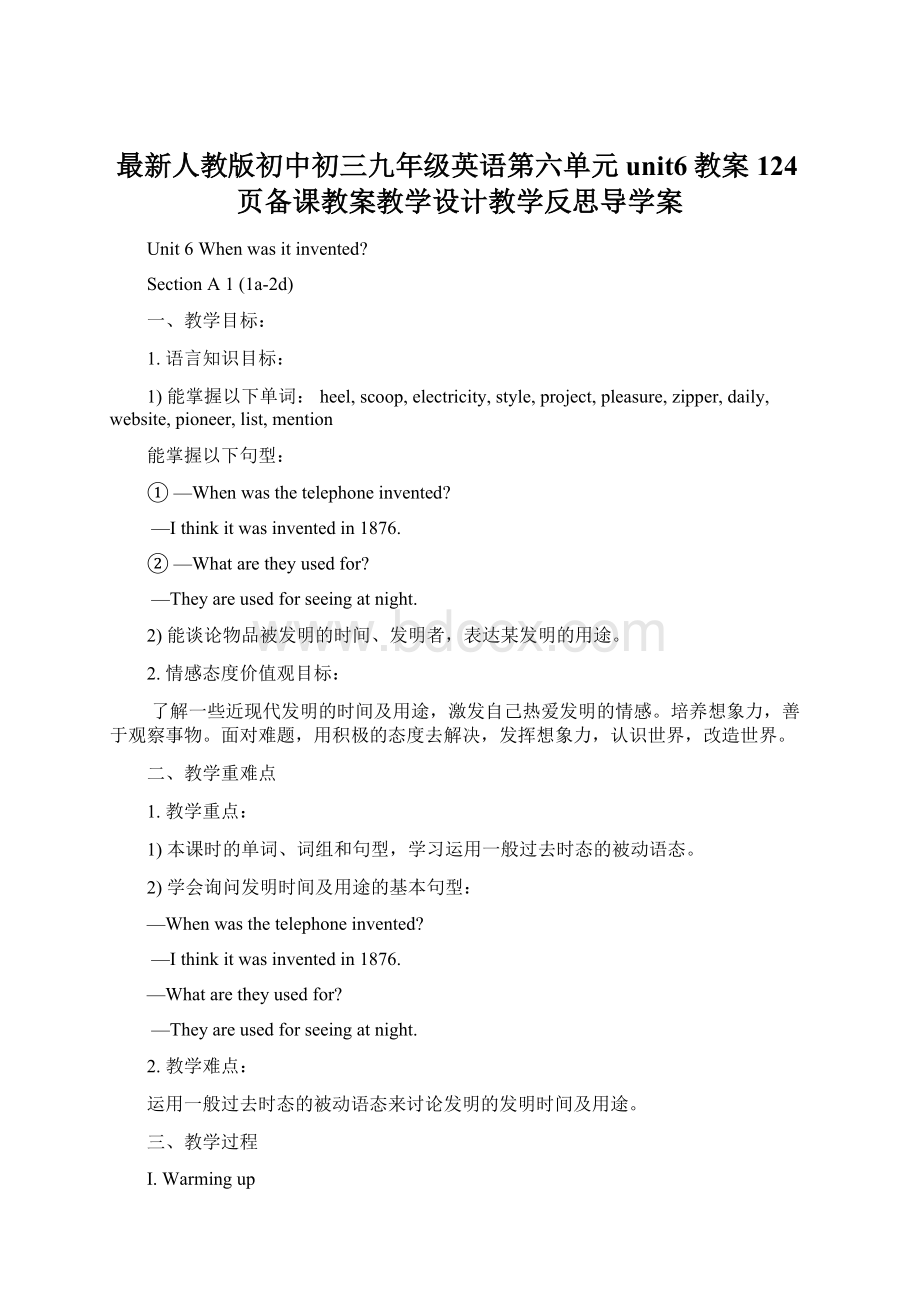最新人教版初中初三九年级英语第六单元unit6教案 124页备课教案教学设计教学反思导学案.docx
《最新人教版初中初三九年级英语第六单元unit6教案 124页备课教案教学设计教学反思导学案.docx》由会员分享,可在线阅读,更多相关《最新人教版初中初三九年级英语第六单元unit6教案 124页备课教案教学设计教学反思导学案.docx(25页珍藏版)》请在冰豆网上搜索。

最新人教版初中初三九年级英语第六单元unit6教案124页备课教案教学设计教学反思导学案
Unit6Whenwasitinvented?
SectionA1(1a-2d)
一、教学目标:
1.语言知识目标:
1)能掌握以下单词:
heel,scoop,electricity,style,project,pleasure,zipper,daily,website,pioneer,list,mention
能掌握以下句型:
①—Whenwasthetelephoneinvented?
—Ithinkitwasinventedin1876.
②—Whataretheyusedfor?
—Theyareusedforseeingatnight.
2)能谈论物品被发明的时间、发明者,表达某发明的用途。
2.情感态度价值观目标:
了解一些近现代发明的时间及用途,激发自己热爱发明的情感。
培养想象力,善于观察事物。
面对难题,用积极的态度去解决,发挥想象力,认识世界,改造世界。
二、教学重难点
1.教学重点:
1)本课时的单词、词组和句型,学习运用一般过去时态的被动语态。
2)学会询问发明时间及用途的基本句型:
—Whenwasthetelephoneinvented?
—Ithinkitwasinventedin1876.
—Whataretheyusedfor?
—Theyareusedforseeingatnight.
2.教学难点:
运用一般过去时态的被动语态来讨论发明的发明时间及用途。
三、教学过程
I.Warmingup
1.展示一些近代发明的图片与近代发明的发明者,让学生们将图片与发明者相连。
T:
Doyouknowwhattheseinventionsare?
S1:
It’sacar.
S2:
It’satelephone.
S3:
It’satelevision.
T:
Doyouknowwhotheseinventorsare?
S1:
KarlBenz
S2:
AlexanderBell
S3:
J.L.Baird
LetSsmatchtheinventionsandtheinventors.
Ⅱ.Presentation
引导学生们学习一般过去时态的被动语态结构。
让学生们看大屏幕的如果爱和发明者的图片,并将句子改为被动语态。
如:
T:
KarlBenzinventedthefirstcarin1885.
Thefirstcarwasinvented(byKarlBenz)in1885.
Ⅲ.Talking
1.Lookatthepicturesin1a.Discusswithyourgroup,inwhatorderdoyouthinktheywereinvented?
Trytonumberthem[1-4].
2.Ssdiscusswiththeirpartnersandnumberthepictures.
3.Talkingabouttheinventions:
A:
IthinktheTVwasinventedbeforethecar.
B:
Well,IthinktheTVwasinventedaftertheTV.
Ⅳ.Listening(1b)
1.T:
TellSslookatthepicturesandyearsontheleft.
2.PlaytherecordingfortheSstolisten.
3.Sslistentotheconversationandtrytomatchtheinventionwiththeproperyear.
4.Playtherecordingagain.
5.Checktheanswers.
Ⅴ.Pairwork(1c)
1.Sstrytoremembertheinventionandtheyear.
2.StudentB,coverthedates.StudentA,askStudentBwhenthethingsinthepicturein1bwereinvented.Thenchangerolesandpracticeagain.
3.Letsomepairsaskandanswerinpairs.
e.g.A:
Whenwasthetelephoneinvented?
B:
Ithinkitwasinventedin1876.
…
Ⅵ.Learningthenewwords&Listening
Lookatthepicturesthenlearnthenewwords.
Workon2a:
T:
TellSstheywillhearsomeinterestinginventions.
1.Lookatthepicturesin2a.Discussthethingswhattheyareusedfor.
2.PlaytherecordingfortheSstolistenandnumberthepictures.
3.Playtherecordingagaintochecktheanswers.
Workon2b:
1.LetSsreadthechartbelow.ExplainsomemainsentencesfortheSs.Makesuretheyknowwhattodo.
2.PlaytherecordingfortheSstofillintheblanks.
3.Playtherecordingagaintochecktheanswers.
4.Listenagainandfillintheblanks.
Ⅶ.Pairwork(2c)
1.TellSstomakeconversationsusingtheinformationin2b.MakeamodelfortheSs.
A:
Whataretheshoeswithspecialheelsusedfor?
B:
Theyareusedforchangingthestyleoftheshoes.
2.LetsomeSsmakeconversationsusingtheinformationin2b.
3.Seewhichgroupdoesthebest.
Ⅷ.Role-play(2d)
1.ReadtheconversationsandLetSsreadaftertheteacher.
2.Explainsomenewwordsandmainpointsintheconversation.
3.AskSstorole-playtheconversationingroups.
X.Languagepoints
1.Well,youdoseemtohaveapoint…
haveapoint有道理
e.g.Iadmit(that)youhaveapoint.我承认你有理。
2.Theyareusedforseeinginthedark.
beusedfordoingsth.表示“被用来做某事”。
相当于beusedtodosth.
e.g.Thiscomputerisusedtocontrolallthemachines.
这台电脑是用来控制所有机器的。
Doyouknowwhatthistoolisusedfor?
你知道这工具是用于做什么的?
3.Thinkabouthowoftenit’susedinourdailylives.
thinkabout表示“考虑,想起”
e.g.Heisthinkingabouttravellinginthesummerholidays.
他正在考虑暑假旅游的事。
Shewasthinkingaboutherchildhooddays.
她正回想她的童年时期。
【拓展有关think其它的短语】
thinkof指“考虑,记忆,记起”
如:
Youthinkofeverything!
你全都提到了。
Ican’tthinkofhisnameatthemoment.我一时想不起他的名字。
thinksth.over指“仔细想,审慎思考,作进一步考虑”
如:
PleasethinkoverwhatIsaid.请仔细考虑我说的话。
Iwanttothinkitover.我想仔细考虑一下这件事。
thinksth.out指“想通,想出,熟思”
如:
Hethoughtoutanewidea.他想出了一个新主意。
Thatwantsthinkingout.那件事需要仔细考虑。
Homework
Recitetheconversationin2d.
教学反思:
SectionA2(3a-3c)
一、教学目标:
1.语言知识目标:
1)学习掌握下列词汇:
byaccident,ruler,boil,remain,smell,saint,national,
takeplace,doubt,withoutdoubt
2)阅读短文,能按要求找到相应的信息。
3)通过阅读提高学生们的阅读能力。
4)了解茶叶被发明的历史及生产制作的简要过程。
2.情感态度价值观目标:
培养想象力,善于观察事物。
面对难题,用积极的态度去解决,发挥想象力,认识世界,改造世界。
二、教学重难点
1.教学重点:
1)掌握本部分出现的生词和词组,达到熟练运用的目标。
2)阅读短文,获得相关的信息。
通过阅读练习,来提高阅读能力。
2.教学难点:
1)阅读短文,获得相关的信息的能力。
2)理解并运用所学的词汇及表达方式。
三、教学过程
Ⅰ.Revision
1.Checkthehomework.
2.Role-playtheconversationin2d.
Ⅱ.Lead-in
一、播放视频《茶叶的起源》,让学生们了解中国的茶文化,及茶叶被发明的渊源,并了解其发展过程。
1.Whatisthevideoabout?
2.WhoisthewriterofChaJing?
Sstrytoanswerthe